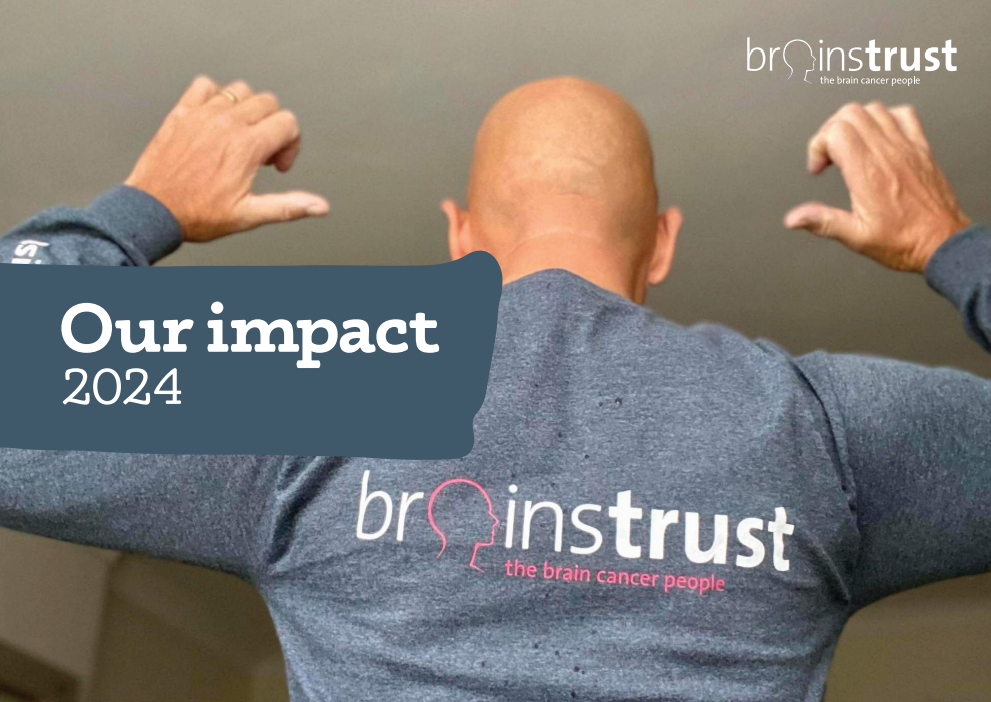 Building Resilience in the Face of Adversity
Building Resilience in the Face of Adversity
What does resilience mean to you? In the current pandemic this is a word that is used a lot and it’s clear that resilience is important in helping us to cope with the challenges that life throws at us. We also know that being told that you have a brain tumour is one of the most difficult things that you can hear and presents huge challenges to our ability to cope. Although we are told that resilience will help us to cope with these tough times, is there anything that we can do to actively try to build this for ourselves?
Sammy Taylor from Beauty in the Brain
Here Sammy, friend of brainstrust and the author of the excellent and inspiring Beauty in the Brain blog, shares with us her thoughts on building resilience when living with a brain tumour diagnosis:
The past 18 months have taught me that resilience isn’t something we choose to be, nor is it a conscious decision we make. Resilience is something that is within us all and is a trait that grows and develops the more that we endure hardships and struggles and overcome the challenges we face.
Whilst anger, grief and sadness are completely normal and justified human responses to many life events, resilience is born from our ability to cope with these hardships and bounce back from setbacks when things don’t seem to go our way.
Although we can’t always choose the situation we find ourselves in, recognizing that change is inevitable, accepting the cards we have been dealt and strengthening our ability to build resilience, means that we can cope with stress and adversity easier.
- Find the opportunity to grow
Being resilient means having the ability to view our challenges as opportunities for growth. Not every situation will be desirable and some of the challenges we are faced with will require tremendous strength. But each will provide a lesson, or insight or a new way of doing things, if you allow it to. There are lessons to be found in every situation, we just have to be able to see them and some of the hardest things we have to go through become the biggest catalysts for change in our lives. No matter how difficult a situation can seem, stop and question “what can I learn from this event.” Doing so will encourage you to find acceptance and gain control of your reactions towards an event.
- Control the controllable and let the rest go
When faced with a health crisis or unexpected diagnosis, it can be so easy to start worrying about events that are entirely out of our control, expecting the worst possible outcome. But doing so is greatly unproductive, not only because most of our worries are fictional and never materialise, but because worrying also results in the feelings of helplessness and lack of power. A lot of our worries stem from internal insecurities and lack in our self-esteem. We worry because we assume that we won’t handle whatever it is that we believe could happen. Whilst we can’t predict the future, or situations we will find ourselves in, we can choose not to worry about events that are out of your control. Instead, decide to face whatever it may be when it comes and trust that if it does, you will handle it, like you have done so with many things in your life.
- Expressive writing
Expressive writing and journaling is something we can do to reduce stress by using the traumatic events in our lives to explore the deep thoughts and feelings we have towards these. Through the insights and understandings we get about our emotions, anxiety triggers and thought patterns, we can confidently analyse behaviours, process events more effectively, discover underlying stressors that might still be present and move forwards through the encouragement to slow down and reflect. Practice getting into the habit of writing down your thoughts freely and uncensored to understand triggers and proactively manage any negative thoughts or behaviours.
- Re-frame your thinking
It can be incredibly difficult to see the lesson or reason for a situation straight away. I felt this in the early days whilst suddenly faced with a stroke and facial paralysis following brain surgery, and needing to relearn the basics at 25 whilst my friends were leading very different lives. You can’t help but catch yourself thinking “why me?”, but I’ve since learnt how helpful it is to remember all the previous versions of yourself, and the past hardships that you couldn’t imagine ever getting through. Suddenly you notice that you made it through all of those things with the strength that got to this point today. Re-frame your thinking and switch your thoughts from “why me” to “why not me.” Choose to see your negative situation from a different, more constructive perspective and notice how trusting you begin to feel about the path you’re on.
- Know that there’s something good in every situation
I know how impossible feeling grateful or seeing the silver linings can seem when we’re in the middle of a really challenging situation. Yet as painful as it might be, there is always something to be thankful for. Finding the positives within a situation, and focusing on those, will allow you to feel more able to cope and accept certain life events. Following my stroke, I was left with permanent nystagmus, which affects almost everything I do by giving me the illusion that the world is constantly moving around me. But despite it, acknowledging how blessed I was to still read my favourite books, watch movies and see loved ones really helped me to find acceptance and adapt to certain physical changes. Although things are much more difficult as a result of my visual impairment, gratitude for having any sight at all has enabled me to remember all the things I can still do within this moment. Challenge yourself to imagine how your situation could be worse than it is and feel encouraged by the realisation that through doing this, you will find a positive that will allow you to appreciate where you are right now. Focus on the thing you’re still physically and mentally able to do, then do more of that.
- Face your fears
When it comes to fears, highly resilient people understand that changes are inevitable and part of life. Whilst a little bit of fear can be a good thing and protects us from danger, most of the time it holds us back from living our lives and pushing ourselves outside of our comfort zones. But the fear of something never goes away for as long as we continue to grow, and we’re always going to experience it whenever we’re faced with something new and unknown. However, the more that we face our fears, the smaller and more manageable they become and when we tackle the things that scare us and eventually overcome them, our confidence and self-esteem skyrockets. The more we practice overcoming our fears, the better prepared we are to face whatever happens in our lives.
- Change self-talk
It’s so easy to immediately overthink a situation or imagine the outcome of it to be far worse than it actually is. But most of the time, this is down to our internal dialogues and the conversations we have with ourselves. The self-talk we adopt not only affects our behaviours towards events, but also our reactions during them. When you catch yourself imagining the worst possible outcomes towards a situation, instead flip it and realise that if the worst possible outcome is possible, then the best is also achievable! We can’t always change or control the events we experience in our lives, but we can control our reactions towards these and how we choose to view them.
- Add meaning to your life
Do something that encourages you to view setbacks with a broader perspective. Volunteering for others, taking up a new hobby or helping a local community encourages us to recharge by doing something that we’re passionate about. Usually by connecting with others through these events, we’re encouraged to put our stresses aside and learn that others are likely overcoming their own challenges and needing support, just like us.
Rather than resenting the obstacles on your path and assuming that life would be better if certain things didn’t happen, realise that life is the obstacles we are faced with. It’s our responsibility to strengthen our ability to navigate these, find calm and peace in the everyday and trust that something better is always just around the corner.
Read more about Sammy’s personal brain tumour journey, and shop her beautiful selection of jewellery (with 10% of profits coming to brainstrust) here.









